EsteéoconteúdodoDrugInformationdaElsevier
TRANSFORMAR COMO VOCÊ USA INFORMAÇÕES SOBRE DROGAS
Saiba mais sobre as informações sobre medicamentos da Elsevier hoje! Obtenha os dados de medicamentos e o suporte à decisão de que você precisa, incluindo TRUE Daily Updates™, incluindo todos os dias, inclusive finais de semana e feriados.
0.2 to 0.5 mg IM; may repeat the dose every 5 to 15 minutes as needed for up to 3 injections. If there is no response after 3 to 4 injections, consider an intravenous infusion.[54255] [60589] [64934] [66054] [66106] [70421] [70422] [70423]
0.01 mg/kg/dose (Max: 0.5 mg/dose) IM; may repeat the dose every 5 to 15 minutes as needed for up to 3 injections. If there is no response after 3 to 4 injections, consider an intravenous infusion.[54255] [60589] [64934] [66106] [70420] [70421] [70422] [70423]
0.01 mg/kg/dose (Max: 0.3 mg/dose) IM; may repeat the dose every 5 to 15 minutes as needed for up to 3 injections. If there is no response after 3 to 4 injections, consider an intravenous infusion.[54255] [60589] [64934] [66106] [70420] [70421] [70422] [70423]
0.2 to 0.5 mg subcutaneously; may repeat the dose every 5 to 15 minutes as needed for up to 3 injections. If there is no response after 3 to 4 injections, consider an intravenous infusion.[54255] [54322] [54323] [60589] [64934] [66054] [66106] Subcutaneous epinephrine is not routinely recommended in the treatment of anaphylaxis due to delayed absorption.[66106]
0.01 mg/kg/dose (Max: 0.5 mg/dose) subcutaneously; may repeat the dose every 5 to 15 minutes as needed for up to 3 injections. If there is no response after 3 to 4 injections, consider an intravenous infusion.[54255] [54322] [54323] [60589] [64934] [66106] Subcutaneous epinephrine is not routinely recommended in the treatment of anaphylaxis due to delayed absorption.[66106]
0.01 mg/kg/dose (Max: 0.3 mg/dose) subcutaneously; may repeat the dose every 5 to 15 minutes as needed for up to 3 injections. If there is no response after 3 to 4 injections, consider an intravenous infusion.[54255] [54322] [54323] [60589] [64934] [66106] Subcutaneous epinephrine is not routinely recommended in the treatment of anaphylaxis due to delayed absorption.[66106]
0.3 mg/dose IM; may repeat the dose for severe persistent anaphylaxis. The patient should not administer more than 2 sequential doses unless under direct medical supervision.[54140] [54257] [57081] [62025]
0.3 mg/dose IM; may repeat the dose for severe persistent anaphylaxis. The patient should not administer more than 2 sequential doses unless under direct medical supervision.[54140] [54257] [57081] [62025]
0.15 mg/dose IM; may repeat the dose for severe persistent anaphylaxis.[54140] [54257] [57081] [62025] Some experts recommend 0.3 mg/dose.[54255] [54293] [64934] The patient should not administer more than 2 sequential doses unless under direct medical supervision.[54140] [54257] [57081] [62025]
0.15 mg/dose IM; may repeat the dose for severe persistent anaphylaxis. The patient should not administer more than 2 sequential doses unless under direct medical supervision.[54140] [54257] [57081] [62025]
0.1 mg/dose IM; may repeat the dose for severe persistent anaphylaxis.[54257] Some experts recommend 0.15 mg/dose.[54255] [54293] [64934] The patient should not administer more than 2 sequential doses unless under direct medical supervision.[54257]
0.1 mg/dose IM; may repeat the dose for severe persistent anaphylaxis. The patient should not administer more than 2 sequential doses unless under direct medical supervision.[54257]
0.3 mg/dose subcutaneously; may repeat the dose for severe persistent anaphylaxis. The patient should not administer more than 2 sequential doses unless under direct medical supervision.[54140] [54257] [57081] [62025] Subcutaneous epinephrine is not routinely recommended in the treatment of anaphylaxis due to delayed absorption.[66106]
0.3 mg/dose subcutaneously; may repeat the dose for severe persistent anaphylaxis. The patient should not administer more than 2 sequential doses unless under direct medical supervision.[54140] [54257] [57081] [62025] Subcutaneous epinephrine is not routinely recommended in the treatment of anaphylaxis due to delayed absorption.[66106]
0.15 mg/dose subcutaneously; may repeat the dose for severe persistent anaphylaxis.[54140] [54257] [57081] [62025] Some experts recommend 0.3 mg/dose.[54255] [54293] [64934] The patient should not administer more than 2 sequential doses unless under direct medical supervision.[54140] [54257] [57081] [62025] Subcutaneous epinephrine is not routinely recommended in the treatment of anaphylaxis due to delayed absorption.[66106]
0.15 mg/dose subcutaneously; may repeat the dose for severe persistent anaphylaxis. The patient should not administer more than 2 sequential doses unless under direct medical supervision.[54140] [54257] [57081] [62025] Subcutaneous epinephrine is not routinely recommended in the treatment of anaphylaxis due to delayed absorption.[66106]
0.1 mg/dose subcutaneously; may repeat the dose for severe persistent anaphylaxis.[54257] Some experts recommend 0.15 mg/dose.[54255] [54293] [64934] The patient should not administer more than 2 sequential doses unless under direct medical supervision.[54257] Subcutaneous epinephrine is not routinely recommended in the treatment of anaphylaxis due to delayed absorption.[66106]
0.1 mg/dose subcutaneously; may repeat the dose for severe persistent anaphylaxis. The patient should not administer more than 2 sequential doses unless under direct medical supervision.[54257] Subcutaneous epinephrine is not routinely recommended in the treatment of anaphylaxis due to delayed absorption.[66106]
0.05 to 0.1 mg (of a 0.1 mg/mL solution) IV every 5 to 15 minutes as needed. Intravenous epinephrine given by boluses may be considered for anaphylactic shock when an IV line is in place.[66054]
0.01 mg/kg/dose (0.1 mL/kg/dose of a 0.1 mg/mL solution) IV every 3 to 5 minutes as needed. Max: 1 mg/dose (10 mL/dose of a 0.1 mg/mL solution).[54254] [54255] [66053]
2 mcg/minute continuous IV infusion, initially. Titrate dose according to blood pressure, cardiac rate, and oxygenation. Max: 15 mcg/minute. Intravenous epinephrine given by continuous infusion may be considered if inadequate response to IM epinephrine and intravenous saline or as an alternative to IV boluses for anaphylactic shock in persons not in cardiac arrest.[66054] [66106]
0.1 to 1 mcg/kg/minute continuous IV infusion. Titrate dose according to blood pressure, cardiac rate, and oxygenation. Intravenous epinephrine given by continuous infusion may be considered if inadequate response to IM epinephrine and intravenous saline.[64934]
2 mg (1 spray) into one nostril, initially. Administer a second dose in the same nostril after 5 minutes if there is no clinical improvement or if symptoms worsen. Seek emergency medical assistance for close monitoring and further evaluation.[71065]
2 mg (1 spray) into one nostril, initially. Administer a second dose in the same nostril after 5 minutes if there is no clinical improvement or if symptoms worsen. Seek emergency medical assistance for close monitoring and further evaluation.[71065]
1 mg (1 spray) into one nostril, initially. Administer a second dose in the same nostril after 5 minutes if there is no clinical improvement or if symptoms worsen. Seek emergency medical assistance for close monitoring and further evaluation.[71065]
1 oral inhalation (0.125 mg); may repeat once after 1 minute if needed. Wait at least 4 hours between doses. Max: 2 inhalations (0.25 mg)/dose and 8 inhalations (1 mg)/day.[63740] Guidelines for asthma treatment do not recommend use; prescribe a selective short-acting beta-agonist (SABA).[33558] [69016]
1 oral inhalation (0.125 mg); may repeat once after 1 minute if needed. Wait at least 4 hours between doses. Max: 2 inhalations (0.25 mg)/dose and 8 inhalations (1 mg)/day.[63740] Guidelines for asthma treatment do not recommend use; prescribe a selective short-acting beta-agonist (SABA).[33558] [69016]
0.3 to 0.5 mg subcutaneously every 20 minutes as needed for up to 3 doses. Guidelines state there is no proven advantage of systemic therapy over the use of inhaled short-acting beta-agonists.[33558] Epinephrine is indicated in addition to standard therapy for acute asthma associated with anaphylaxis or angioedema. It is not routinely indicated for other asthma exacerbations.[69016]
0.3 to 0.5 mg subcutaneously every 20 minutes as needed for up to 3 doses. Guidelines state there is no proven advantage of systemic therapy over the use of inhaled short-acting beta-agonists.[33558] Epinephrine is indicated in addition to standard therapy for acute asthma associated with anaphylaxis or angioedema. It is not routinely indicated for other asthma exacerbations.[69016]
0.01 mg/kg/dose (Max: 0.5 mg/dose) subcutaneously every 20 minutes as needed for up to 3 doses may be given if an inhaled short-acting beta-agonist (e.g., albuterol) is not available. Guidelines state there is no proven advantage of systemic therapy over the use of inhaled short-acting beta-agonists.[33558] Epinephrine is indicated in addition to standard therapy for acute asthma associated with anaphylaxis or angioedema. It is not routinely indicated for other asthma exacerbations.[69016]
0.3 to 0.5 mg/dose IM every 5 to 15 minutes as needed for up to 3 doses. Reserved for patients with poor inspiratory flow, those who cannot cooperate with inhaled therapy, or those with severe asthma with suboptimal response to initial aerosolized therapy.[60589] [64934] Intramuscular epinephrine is indicated in addition to standard therapy for acute asthma associated with anaphylaxis or angioedema. It is not routinely indicated for other asthma exacerbations.[69016]
0.01 mg/kg/dose (Max: 0.5 mg/dose) IM every 5 to 15 minutes as needed for up to 3 doses. Reserved for patients with poor inspiratory flow, those who cannot cooperate with inhaled therapy, or those with severe asthma with suboptimal response to initial aerosolized therapy.[64934] Intramuscular epinephrine is indicated in addition to standard therapy for acute asthma associated with anaphylaxis or angioedema. It is not routinely indicated for other asthma exacerbations.[69016]
0.01 mg/kg/dose (Max: 0.3 mg/dose) IM every 5 to 15 minutes as needed for up to 3 doses. Reserved for patients with poor inspiratory flow, those who cannot cooperate with inhaled therapy, or those with severe asthma with suboptimal response to initial aerosolized therapy.[64934] Intramuscular epinephrine is indicated in addition to standard therapy for acute asthma associated with anaphylaxis or angioedema. It is not routinely indicated for other asthma exacerbations.[69016]
0.5 mL/kg/dose (Max: 5 mL/dose) of 1 mg/mL solution diluted in 2 to 2.5 mL of saline inhaled by nebulizer every 20 minutes as needed as an alternative if racemic epinephrine is not available; 5 mL of L-epinephrine 1 mg/mL is equivalent to 0.5 mL of racemic epinephrine 2.25%. In general, improvement is seen within 10 to 30 minutes and lasts 2 hours after administration.[54245] [54247] [54249] [54250] [59632] [64934]
0.3 to 0.5 mL of 1 mg/mL solution subcutaneously or IM every 1 to 2 hours.
1 mg IV or IO every 3 to 5 minutes as needed. For a nonshockable rhythm, administer epinephrine as soon as possible. For a shockable rhythm, administer epinephrine after initial defibrillation attempts have failed. High-dose epinephrine is not recommended for routine use. Do not interrupt CPR to administer drug therapy.[66054]
0.01 mg/kg/dose (Max: 1 mg/dose) IV or IO every 3 to 5 minutes as needed. High-dose epinephrine is not recommended for routine use. Do not interrupt CPR to administer drug therapy.[43713] [63412] [66053]
0.01 to 0.03 mg/kg/dose IV or IO every 3 to 5 minutes as needed. High-dose epinephrine is not recommended for routine use. Do not interrupt CPR to administer drug therapy.[44520] [52326] [66055]
2 to 2.5 mg ET every 3 to 5 minutes as needed until vascular access is obtained. For a nonshockable rhythm, administer epinephrine as soon as possible. For a shockable rhythm, administer epinephrine after initial defibrillation attempts have failed.[45649] [66054]
0.1 mg/kg/dose (Max: 2.5 mg/dose) ET every 3 to 5 minutes as needed until vascular access obtained.[43713] [64934] [66053]
0.05 to 0.1 mg/kg/dose ET every 3 to 5 minutes as needed until vascular access is obtained.[44520] [52326] [64934] [66055]
0.3 to 0.5 mg intracardially. Follow administration with external cardiac massage to permit the drug to enter the coronary circulation.[45416] [49567]
2 to 10 mcg/minute continuous IV or IO infusion; titrate to desired effect.[45649] [66054]
0.1 to 1 mcg/kg/minute continuous IV or IO infusion; titrate to desired effect.[43713] [66053]
0.1 to 1 mcg/kg/minute continuous IV or IO infusion; titrate to desired effect.[43713] [66053]
0.001 mg/kg/dose IV or IO (one-tenth the standard resuscitation dose); titrate to desired hemodynamic effect. A continuous infusion of 0.01 to 0.2 mcg/kg/minute IV or IO has also been recommended.[63412]
2 to 10 mcg/minute or 0.1 to 0.5 mcg/kg/minute continuous IV or IO infusion. Titrate to desired effect.[45649] [60266] [63867]
0.01 mg/kg/dose (0.1 mL/kg/dose of a 0.1 mg/mL solution) IV or IO; may repeat every 3 to 5 minutes. Max: 1 mg/dose (10 mL of a 0.1 mg/mL solution). Do not interrupt CPR to administer drug therapy. Higher doses of epinephrine are not recommended except when indicated for exceptional circumstances (e.g., beta-blocker overdosage).[43713] [60636]
0.01 to 0.03 mg/kg/dose (0.1 to 0.3 mL/kg/dose of a 0.1 mg/mL solution) IV; may repeat every 3 to 5 minutes. Do not interrupt CPR to administer drug therapy. After administration, flush the IV line with 0.5 to 1 mL of 0.9% Sodium Chloride Injection to ensure drug delivery. Higher doses of epinephrine are not recommended.[44520] [52326] [61541]
0.1 mg/kg/dose (0.1 mL/kg/dose of a 1 mg/mL solution) ET; may repeat every 3 to 5 minutes until vascular access obtained. Max: 2.5 mg/dose (2.5 mL/dose of a 1 mg/mL solution). If CPR is in progress, stop chest compressions briefly to administer medication. Follow ET administration with saline flush or dilute the drug in isotonic saline (5 mL or more) and deliver several consecutive positive-pressure ventilations.[43713] [60636] [64934]
0.05 to 0.1 mg/kg/dose (0.5 to 1 mL/kg/dose of a 0.1 mg/mL solution) ET; may repeat every 3 to 5 minutes until vascular access is obtained. Follow ET administration with saline flush or dilute the drug in isotonic saline (0.5 to 1 mL) and deliver several consecutive positive-pressure ventilations.[44520] [52326] [61541] [64934]
0.01 to 2 mcg/kg/minute continuous IV infusion. Titrate dose by 0.05 to 0.2 mcg/kg/minute every 10 to 15 minutes based on clinical response.[45416] [56575] [60589] [65299] After hemodynamic stabilization, wean incrementally every 10 to 30 minutes over 12 to 24 hours.[56575] [60589] Use ideal body weight as the weight parameter for dosing.[72047]
0.1 to 1 mcg/kg/minute continuous IV infusion. Titrate dose as needed based on clinical response. Doses up to 5 mcg/kg/minute may be necessary for shock.[43713] [44772] [64934] [66053]
0.1 to 1 mcg/kg/minute continuous IV infusion. Titrate dose as needed based on clinical response. Doses up to 5 mcg/kg/minute may be necessary for shock.[43713] [44772] [64934] [66053]
Apply 0.002% to 0.1% solutions topically.
NOTE: These products are discontinued in the U.S. Instill 1 to 2 drops of 0.5%, 1% or 2% ophthalmic solution into affected eye(s) once or twice daily.
Initially, 0.25 mcg/kg/minute and increase by 0.25 mcg/kg/minute to maintain a systolic blood pressure of 100 mmHg or more in combination with IV diazepam, general anesthesia with thiopental, and FiO2 40%. Diazepam was continued for 2 to 4 additional days. Other vasopressors and/or inotropic agents were used as necessary. Eleven cases of acute chloroquine overdose (total ingested dose ranged from 5 to 12 g) were treated with epinephrine; 10 patients were discharged alive from the hospital. The 1 patient who died ingested the largest total dose (15 g) of chloroquine.[23704]
NOTE: The FDA is warning health care professionals not to use unapproved epinephrine nasal solutions manufactured by BPI Labs LLC and Endo USA. Health care professionals have confused these products with FDA-approved injectable epinephrine products for intravenous use. BPI Labs and Endo USA nasal solutions products should never be injected intravenously. These products, which pre-date the 1938 Federal Food, Drug & Cosmetic Act, were never submitted for approval by the FDA, and therefore, are unapproved drugs for which safety and efficacy have not been established and are subject to recall. The FDA has determined these products to be misbranded with a misleading label similar in appearance to FDA-approved epinephrine injections, USP. The similarity in labeling makes it difficult to distinguish between the non-sterile topical and sterile injectable products which can lead to potential administration errors and safety issues. Endo USA, Inc., is voluntarily recalling all lots of Adrenalin Chloride Solution (epinephrine nasal solution) 30mg/30mL. The FDA has recommended BPI Labs to also recall its unapproved epinephrine nasal solution.[71701][71793]
Apply topically to nose as drops, spray, or with a sterile swab as needed.[46634]
Apply topically to nose as drops, spray, or with a sterile swab as needed.[46634]
Must dilute prior to intraocular use. Dilute 1 mL of epinephrine 1 mg/mL in 100 to 1,000 mL of an ophthalmic irrigation fluid to create an epinephrine concentration of 10 mcg/mL to 1 mcg/mL. Use the irrigating solution as needed for the surgical procedure. After dilution in an ophthalmic irrigating fluid, the solution may also be injected intracamerally as a bolus dose of 0.1 mL at a dilution of 10 mcg/mL to 2.5 mcg/mL.[60589] Check product specific labels; only use 1 mg/mL single-use products intended for ophthalmic administration.
Must dilute prior to intraocular use. Dilute 1 mL of epinephrine 1 mg/mL in 100 to 1,000 mL of an ophthalmic irrigation fluid to create an epinephrine concentration of 10 mcg/mL to 1 mcg/mL. Use the irrigating solution as needed for the surgical procedure. After dilution in an ophthalmic irrigating fluid, the solution may also be injected intracamerally as a bolus dose of 0.1 mL at a dilution of 10 mcg/mL to 2.5 mcg/mL.[60589] Check product specific labels; only use 1 mg/mL single-use products intended for ophthalmic administration.
Soak gauze or a cotton pledget in 0.1 to 1 mg/mL solution and place in the affected nostril(s) for 30 minutes.[65040] [65041] [65042]
Dependent on route of administration and indication for therapy. For CPR, 0.01 mg/kg/dose (Max: 1 mg/dose) IV/IO and 0.1 mg/kg/dose (Max: 2.5 mg/dose) ET. For anaphylaxis, 2 mg/dose intranasally (Neffy) and 0.01 mg/kg/dose (Max: 0.5 mg/dose IM/subcutaneously and 1 mg/dose IV). For asthma, 0.01 mg/kg/dose (Max: 0.5 mg/dose) IM/subcutaneously or 8 oral inhalations/24 hours of epinephrine 0.125 mg oral inhalation (e.g., Primatene Mist inhaler, non-prescription).
Dependent on route of administration and indication for therapy. For CPR, 0.01 mg/kg/dose (Max: 1 mg/dose) IV/IO and 0.1 mg/kg/dose (Max: 2.5 mg/dose) ET. For anaphylaxis, 2 mg/dose intranasally (Neffy) and 0.01 mg/kg/dose (Max: 0.5 mg/dose IM/subcutaneously and 1 mg/dose IV). For asthma, 0.01 mg/kg/dose (Max: 0.5 mg/dose) IM/subcutaneously or 8 oral inhalations/24 hours of epinephrine 0.125 mg oral inhalation (e.g., Primatene Mist inhaler, non-prescription).
Dependent on route of administration and indication for therapy. For CPR, 0.01 mg/kg/dose (Max: 1 mg/dose) IV/IO and 0.1 mg/kg/dose (Max: 2.5 mg/dose) ET. For anaphylaxis, 2 mg/dose intranasally (Neffy) and 0.01 mg/kg/dose (Max: 0.5 mg/dose IM/subcutaneously and 1 mg/dose IV). For asthma, 0.01 mg/kg/dose (Max: 0.5 mg/dose) IM/subcutaneously or 8 oral inhalations/24 hours of epinephrine 0.125 mg oral inhalation (e.g., Primatene Mist inhaler, non-prescription).
12 years: Dependent on route of administration and indication for therapy. For CPR, 0.01 mg/kg/dose (Max: 1 mg/dose) IV/IO and 0.1 mg/kg/dose (Max: 2.5 mg/dose) ET. For anaphylaxis, 2 mg/dose intranasally (Neffy) and 0.01 mg/kg/dose (Max: 0.5 mg/dose IM/subcutaneously and 1 mg/dose IV). For asthma, 0.01 mg/kg/dose (Max: 0.5 mg/dose) IM/subcutaneously or 8 oral inhalations/24 hours of epinephrine 0.125 mg oral inhalation (e.g., Primatene Mist inhaler, non-prescription).
4 to 11 years weighing more than 30 kg: Dependent on route of administration and indication for therapy. For CPR, 0.01 mg/kg/dose (Max: 1 mg/dose) IV/IO and 0.1 mg/kg/dose (Max: 2.5 mg/dose) ET. For anaphylaxis, 2 mg/dose intranasally (Neffy), 0.01 mg/kg/dose (Max: 0.5 mg/dose IM/subcutaneously and 1 mg/dose IV). For asthma, 0.01 mg/kg/dose (Max: 0.5 mg/dose) IM/subcutaneously.
4 to 11 years weighing 30 kg: Dependent on route of administration and indication for therapy. For CPR, 0.01 mg/kg/dose (Max: 1 mg/dose) IV/IO and 0.1 mg/kg/dose (Max: 2.5 mg/dose) ET. For anaphylaxis, 2 mg/dose intranasally (Neffy) and 0.01 mg/kg/dose (Max: 0.3 mg/dose IM/subcutaneously and 1 mg/dose IV). For asthma, 0.01 mg/kg/dose (Max: 0.5 mg/dose) IM/subcutaneously.
4 to 11 years weighing 15 kg to 29 kg: Dependent on route of administration and indication for therapy. For CPR, 0.01 mg/kg/dose (Max: 1 mg/dose) IV/IO and 0.1 mg/kg/dose (Max: 2.5 mg/dose) ET. For anaphylaxis, 1 mg/dose intranasally (Neffy) and 0.01 mg/kg/dose (Max: 0.3 mg/dose IM/subcutaneously and 1 mg/dose IV). For asthma, 0.01 mg/kg/dose (Max: 0.3 mg/dose) IM/subcutaneously.
4 to 11 years weighing less than 15 kg: Dependent on route of administration and indication for therapy. For CPR, 0.01 mg/kg/dose (Max: 1 mg/dose) IV/IO and 0.1 mg/kg/dose (Max: 2.5 mg/dose) ET. For anaphylaxis, 0.01 mg/kg/dose (Max: 0.3 mg/dose IM/subcutaneously and 1 mg/dose IV). For asthma, 0.01 mg/kg/dose (Max: 0.3 mg/dose) IM/subcutaneously.
1 to 3 years: Dependent on route of administration and indication for therapy. For CPR, 0.01 mg/kg/dose (Max: 1 mg/dose) IV/IO and 0.1 mg/kg/dose (Max: 2.5 mg/dose) ET. For anaphylaxis, 0.01 mg/kg/dose (Max: 0.3 mg/dose IM/subcutaneously and 1 mg/dose IV). For asthma, 0.01 mg/kg/dose (Max: 0.3 mg/dose) IM/subcutaneously.
Dependent on route of administration and indication for therapy. 0.01 mg/kg/dose (Max: 1 mg/dose) IV or IO for CPR; 0.1 mg/kg/dose (Max 2.5 mg/dose) ET for CPR; 0.01 mg/kg/dose (Max: 0.3 mg/dose) IM or subcutaneously for anaphylaxis; 0.01 mg/kg/dose (Max: 0.3 mg/dose) IM for asthma.
Dependent on route of administration and indication for therapy. For CPR, 0.03 mg/kg/dose IV and 0.1 mg/kg/dose ET.
Specific guidelines for dosage adjustments in hepatic impairment are not available; it appears that no dosage adjustments are needed.
Specific guidelines for dosage adjustments in renal impairment are not available; it appears that no dosage adjustments are needed.
† Off-label indication
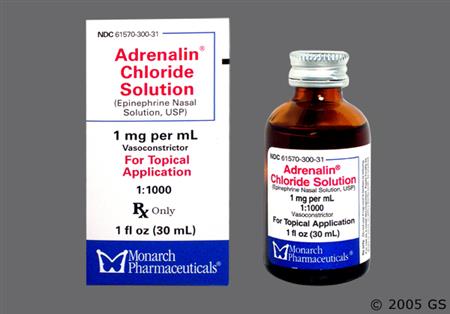
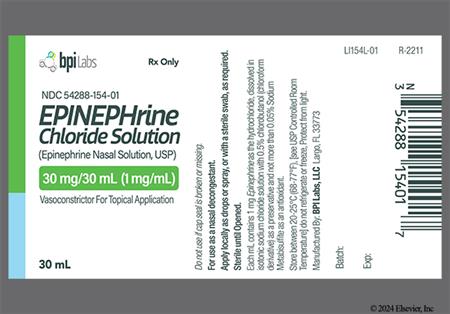
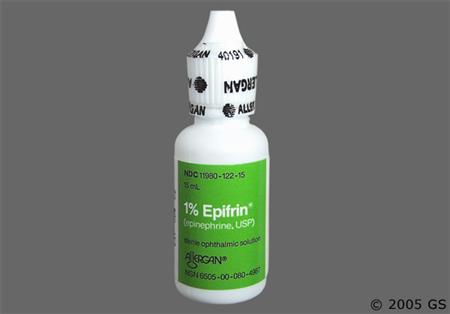
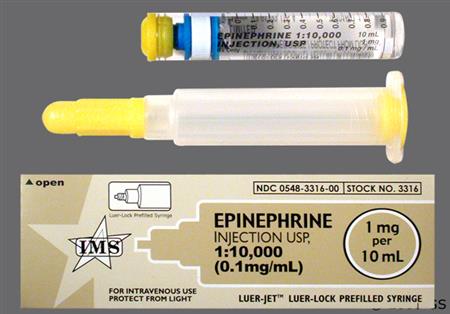


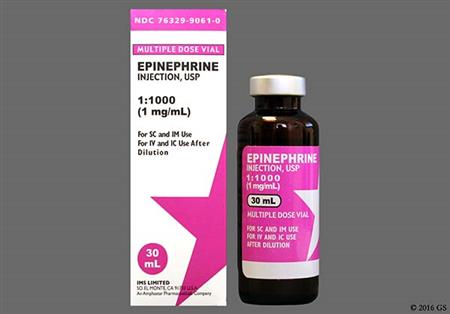
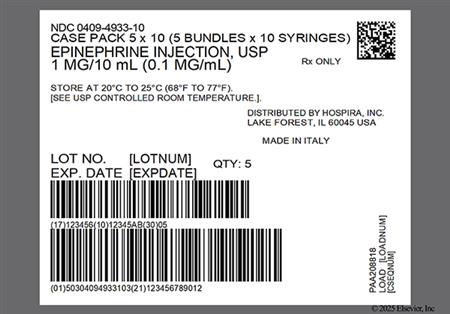
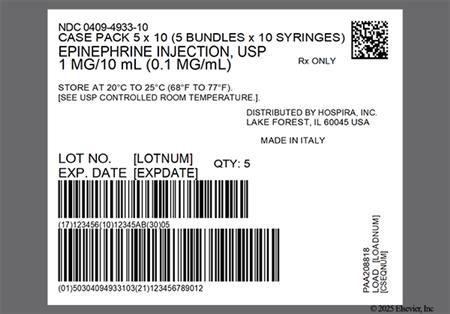
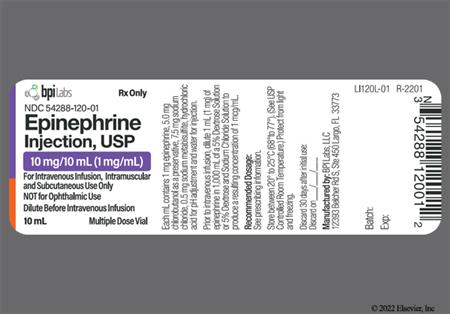

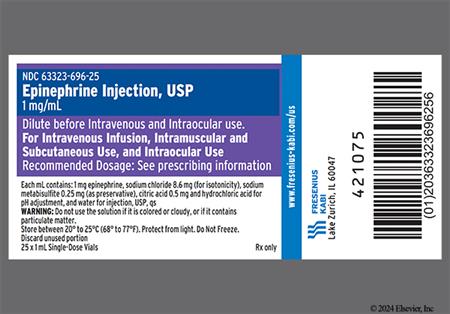
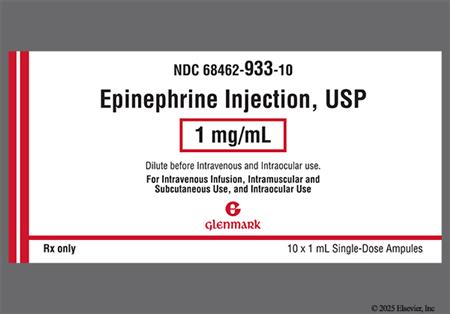


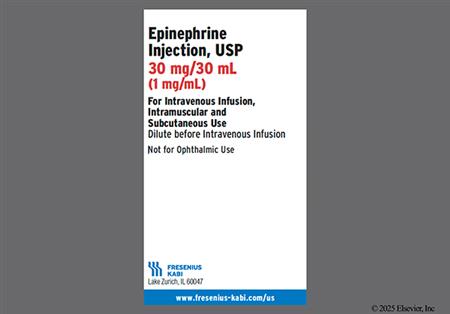
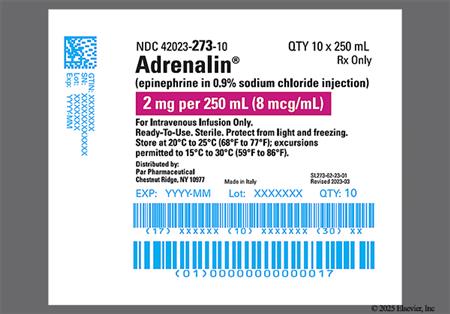
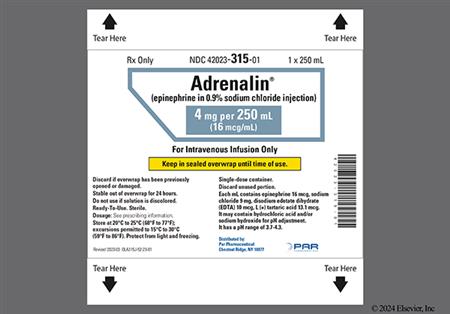
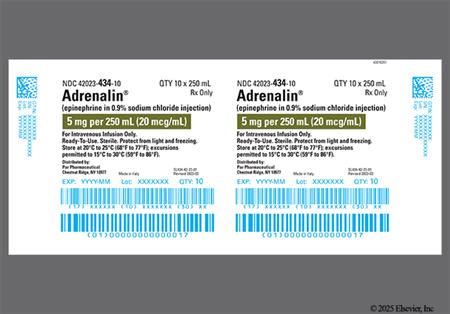


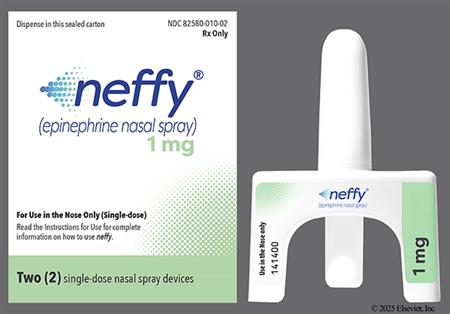
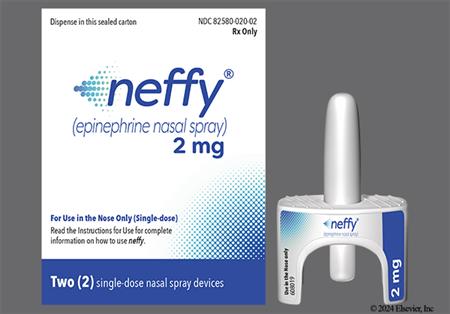

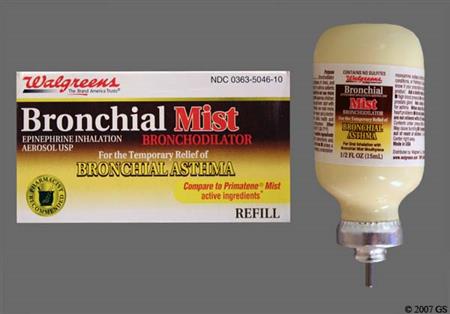
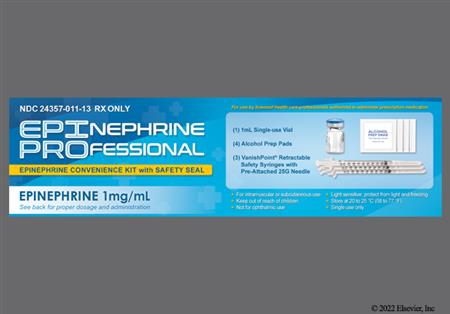

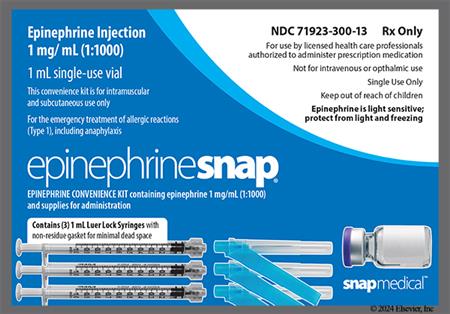

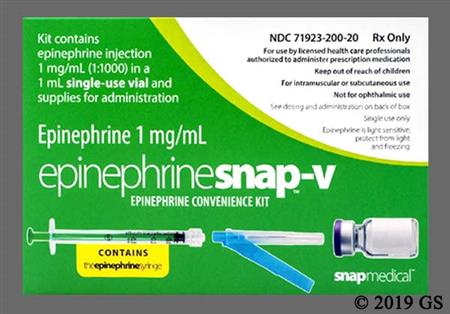
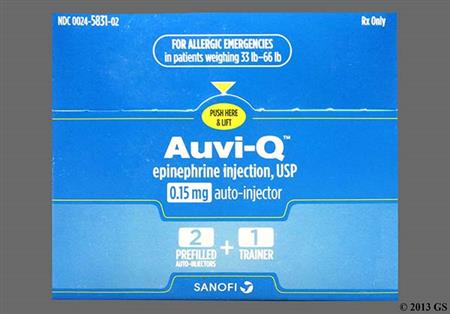

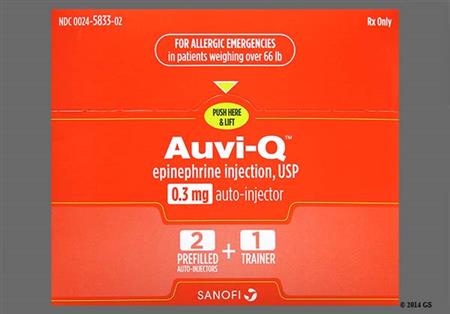

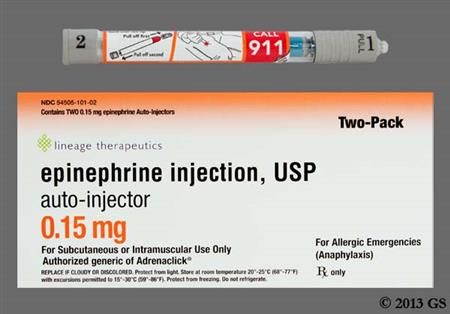
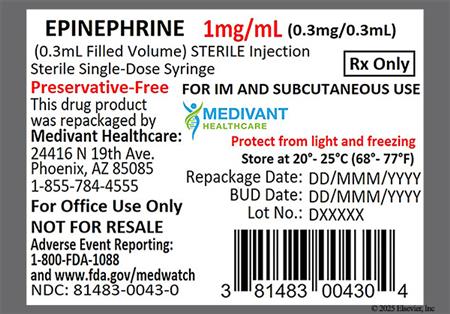
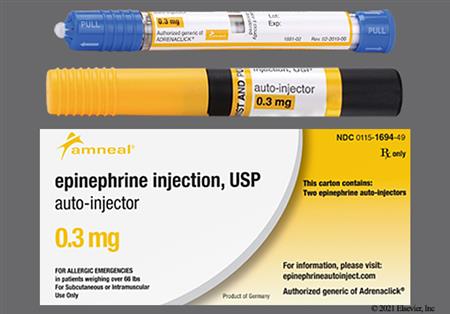
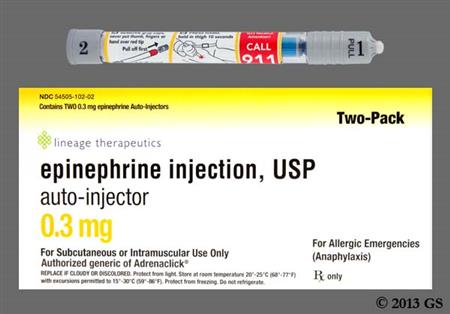
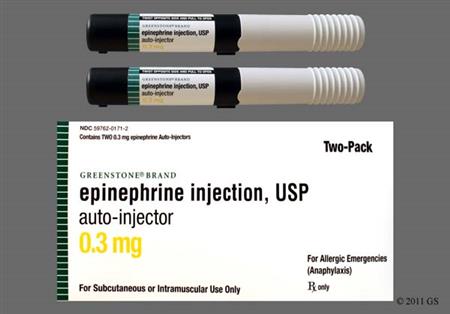

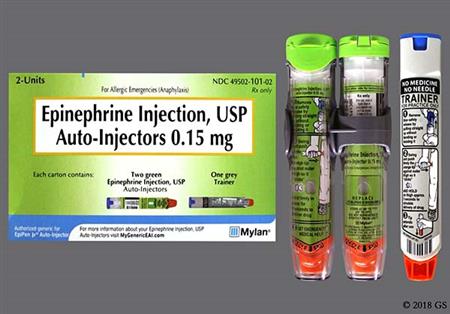


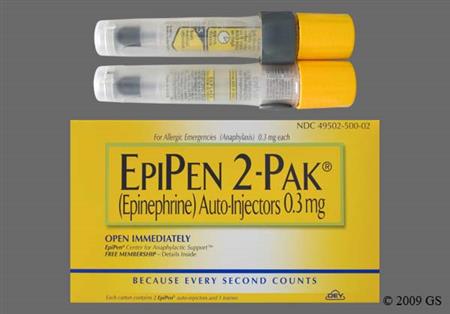
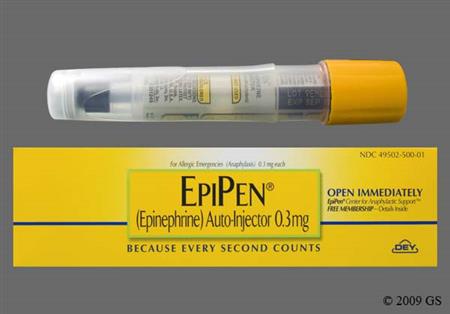
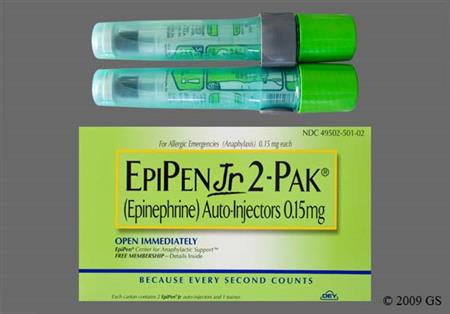

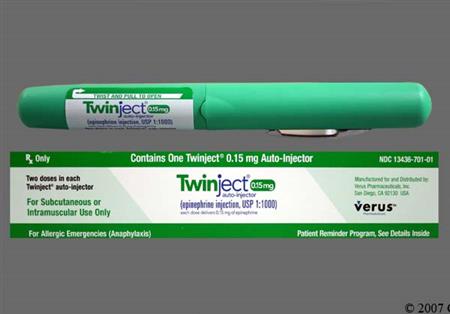

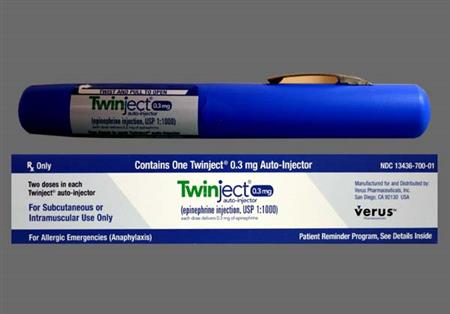


Epinephrine is a nonselective adrenergic agonist with a high affinity for beta1-, beta2-, and alpha1-receptors. Exogenous epinephrine is a sympathomimetic catecholamine with dose-dependent effects; beta-adrenergic effects (e.g., inotropy, vasodilation) are more pronounced at low doses and alpha-adrenergic effects (e.g., vasoconstriction) at high doses.[43713][54334][54335] Epinephrine has many therapeutic applications. Intramuscular epinephrine and epinephrine nasal spray (Neffy) are indicated for emergency treatment of type I allergic reactions, including anaphylaxis.[54140][71065] Intravenous epinephrine is recommended during cardiopulmonary resuscitation, specifically for the treatment of symptomatic bradycardia, cardiac arrest, and as an adjunct to electrical defibrillation in ventricular fibrillation/pulseless ventricular tachycardia. Additionally, epinephrine is used for hypotension, fluid-resistant shock, and inotropic support in a variety of settings (e.g., postresuscitation and postoperative).[43713][45649][66053][66054][67037] Intravenous epinephrine is the vasopressor of choice in anaphylactic shock, as it provides beta2 stimulation.[65559] In patients with sinus node dysfunction or second- or third-degree atrioventricular block associated with symptoms of hemodynamic compromise who are at a low likelihood of coronary ischemia, epinephrine may be considered to increase heart rate, improve atrioventricular conduction, increase ventricular rate, and improve symptoms.[63867] Inhaled epinephrine is used as a bronchodilator for the treatment of severe croup symptoms in young children.[59632] However, clinical guidelines do not recommend inhaled epinephrine in asthma or bronchiolitis.[58442][66299] Additionally, injectable epinephrine is only recommended as an adjunct to standard asthma therapy for an acute asthma exacerbation associated with anaphylaxis and angioedema; epinephrine is not recommended routinely for other asthma exacerbations.[69016][64934]
NOTE: The FDA is warning health care professionals not to use unapproved epinephrine nasal solutions manufactured by BPI Labs LLC and Endo USA. Health care professionals have confused these products with FDA-approved injectable epinephrine products for intravenous use. BPI Labs and Endo USA nasal solutions products should never be injected intravenously. The nasal solution and injectable products have similar packaging and are manufactured by the same companies. These products, which pre-date the 1938 Federal Food, Drug & Cosmetic Act, were never submitted for approval by the FDA, and therefore, are unapproved drugs for which safety and efficacy have not been established and are subject to recall. The similarity in labeling makes it difficult to distinguish between the non-sterile topical and sterile injectable products, which can lead to potential administration errors. Intravenous administration of the unapproved non-sterile topical epinephrine nasal solutions, instead of the approved sterile epinephrine injection would result in nonfatal serious and/or severe, health outcomes related to delayed or inadequate treatment of the underlying condition (anaphylaxis, hemodynamic instability, hypotension) or infection due to intravenous administration of a non-sterile product. In addition, there is a high probability that intravenous administration of the nasal product will result in patients receiving the wrong dose of epinephrine in emergency situations, potentially increasing the risk for death. Endo USA, Inc., is voluntarily recalling all lots of Adrenalin Chloride Solution (epinephrine nasal solution) 30mg/30mL (1mg/mL) 30 mL vials, to the consumer level. Endo is providing written notification to all direct customer accounts that have received the affected product lots and is arranging for the return of all existing inventory through Inmar, Inc. Wholesale distributors that have product lots being recalled should immediately discontinue use and stop distribution immediately. Questions regarding this recall can be directed to Inmar, Inc. at 1-877-560-8453. FDA recommended BPI Labs recall its unapproved Epinephrine nasal solution on Dec. 12, 2024. The agency followed up with the company several times to reiterate this recommendation. The latest adverse event report FDA received involved the product with BPI Labs. BPI Labs has not acted to remove its unapproved drug from the market.[71701][71793]
For storage information, see the specific product information within the How Supplied section.
IV Push
Continuous IV Infusion
Dilution
Administration
Extravasation Management
Intraosseous Administration
NOTE: Epinephrine is not FDA-approved for intraosseous administration.
Intracardiac Administration
Topical Nasal Administration
NOTE: Topical nasal administration is not an approved administration route. Adrenalin Nasal Solution has been recalled as this product was never submitted for FDA approval, and is an unapproved drug for which safety and efficacy have not been established. Do not ever inject this product; it is not sterile.[71701][71793]
Inhalation Aerosol Solution
Nasal Spray (Neffy)
Administration
Irrigation for intraocular use
Intracameral injection for intraocular use
Endotracheal Administration
NOTE: Epinephrine is not FDA-approved for endotracheal (ET) administration.
Transient anxiety, apprehension, fear, restlessness, tremor, weakness, dizziness, and headache are common with systemic epinephrine use. Disorientation, excitability, memory impairment, lightheadedness, nervousness, panic, psychomotor agitation, drowsiness, tingling, and paresthesias have also been reported.[45416] [56575] [60589] Headache (6% to 18%), feeling jittery (1% to 11%), tremor (8% or less), and dizziness (2% to 3%) were reported in adults receiving epinephrine nasal spray (Neffy). Fatigue (10%), paresthesia (10%), and feeling jittery (10%) were reported in pediatric subjects receiving epinephrine nasal spray (Neffy).[71065] Individuals with Parkinson disease may experience psychomotor agitation or a temporary worsening of symptoms.[45416] [56575] [60589]
Nausea, vomiting, diaphoresis, pallor, and respiratory difficulties are common with systemic epinephrine administration. Piloerection (gooseflesh) has also been reported with epinephrine infusions.[56575] [60589] Nausea (2% to 3%), vomiting (2%), and abdominal pain (1% to 4%) were reported in adults receiving epinephrine nasal spray (Neffy).[71065]
Cardiac arrhythmias (or arrhythmia exacerbation), including palpitations, sinus tachycardia, supraventricular tachycardia (SVT), and severe ventricular arrhythmias (ventricular ectopy, ventricular fibrillation) have been reported with epinephrine, most commonly in individuals with underlying cardiac disease or in those receiving drugs that sensitize the myocardium. Rapid rises in blood pressure and severe hypertension may result in cerebral hemorrhage, subarachnoid hemorrhage, hemiplegia, or stroke. Chest pain (unspecified), angina, myocardial ischemia, and myocardial infarction have also been associated with epinephrine infusion. Epinephrine increases cardiac output and causes peripheral vasoconstriction, which may cause pulmonary edema. Rales have been reported. If pulmonary edema occurs, administer a rapid acting alpha-adrenergic blocking drug (e.g., phentolamine) and provide respiratory support. Stress cardiomyopathy has also been reported with epinephrine use.[45416] [56575] [60589] [71065]
Epinephrine is a potent vasoconstrictor. Instruct individuals to seek immediate medical care in the case of accidental injection into the fingers, hands, or feet as this may result in loss of blood flow to those areas which may present as site pallor, coldness, or hypoesthesia.[57081] Extravasation of intravenous epinephrine can result in an injection site reaction leading to severe tissue damage and tissue necrosis. If skin blanching along the course of the infused vein occurs, consider changing the infusion site at intervals to allow the effects of local vasoconstriction to subside. If extravasation of intravenous drug or accidental digital injection occurs, infiltrate the area with a saline solution containing phentolamine; inject liberally throughout the ischemic area using a fine hypodermic needle. The ischemic area may be identified by a cool, hard, and pallid appearance. Sympathetic blockade with phentolamine causes immediate and noticeable local hyperemic changes if the area is infiltrated within 12 hours of extravasation.[54685] [60589] Skin laceration and bent or embedded needles have been reported when epinephrine has been injected into the thigh of young children who are uncooperative; instruct caregivers to hold the child's leg firmly to limit movement prior to and during injection. Rare cases of serious skin and soft tissue infection, including necrotizing fasciitis and myonecrosis caused by Clostridia (gas gangrene) have been reported at the injection site when used for anaphylaxis. Injection site ecchymosis, bleeding, skin discoloration, erythema, and skeletal injury have also been associated with intramuscular and subcutaneous use.[57081]
Hypoglycemia, hyperglycemia, insulin resistance, hypokalemia, and lactic acidosis have been associated with intravenous epinephrine infusion.[60589] Epinephrine can increase blood glucose and lactate concentrations via stimulation of beta-receptors.[65550]
Intravenously administered epinephrine may constrict renal blood vessels, resulting in oliguria or renal impairment.[56575] [60589]
Epinephrine products containing sodium bisulfite have been associated with corneal endothelial damage and corneal edema when used in the eye at undiluted concentrations (1 mg/mL).[60589]
Throat irritation (2% to 19%), nasal pruritus (4% or less), gingival pain (4% or less), oral hypoesthesia (4% or less), and nasal congestion (2% or less) were reported in adults receiving epinephrine nasal spray (Neffy). Nasal discomfort (10% to 19%), rhinorrhea (3% to 19%), and sneezing (4% to 14%) were reported in adults as well as pediatric patients receiving epinephrine nasal spray (Neffy). In pediatric patients, intranasal paresthesia (19%), nasal congestion (19%), upper respiratory tract congestion (14%), epistaxis (10%), dry throat (10%), nasal dryness (10%), and rhinalgia (10%) were reported after receiving epinephrine nasal spray (Neffy).[71065]
Although there are no absolute contraindications to the use of parenteral epinephrine when used in acute, life-threatening situations, some product labeling describe epinephrine as contraindicated in persons with known hypersensitivity to sympathomimetic amines, such as epinephrine.[45416]
Although there are no absolute contraindications to the use of parenteral epinephrine when used in acute, life-threatening situations, some product labeling states epinephrine is contraindicated in patients with cardiac dilatation, coronary insufficiency, and other cardiovascular disorders.[45416] [49567] Epinephrine may induce arrhythmias, myocardial ischemia, and angina pectoris, especially in individuals with pre-existing cardiac arrhythmias, coronary artery disease, cardiomyopathy, organic cardiac disease, high blood pressure, or those receiving drugs that sensitize the myocardium.[54140] [56575] [60589] [71065] Certain epinephrine formulations that are intended only for hypersensitivity reactions, cardiac resuscitation, ophthalmological use, or regional anesthesia are contraindicated in nonanaphylactic shock.[45416] [49567] However, other epinephrine formulations are indicated for hypotension associated with septic shock.[56575] [60589] Correct hypovolemia as fully as possible before any vasopressor is administered. When, as an emergency measure, intra-aortic pressures must be maintained to prevent cerebral or coronary artery ischemia, epinephrine can be administered before and concurrently with blood volume replacement.[60589]
Some epinephrine products contain sodium metabisulfite. The presence of sulfites should not deter epinephrine administration for the treatment of serious allergic reactions or other emergency situations, even in those with sulfite hypersensitivity. Alternatives to epinephrine in a life-threatening situation may not be satisfactory.[45416] [56575] [71065]
Although there are no absolute contraindications to the use of parenteral epinephrine when used in acute, life-threatening situations, some product labeling states epinephrine is contraindicated in closed-angle glaucoma because it can exacerbate this condition.[45416] [49567]
Epinephrine is a potent vasoconstrictor; inadvertent digital or intraarterial administration can lead to vasoconstriction, vasospasm, thrombosis, and subsequent tissue necrosis. Epinephrine and epinephrine-containing products (e.g., local anesthetics with epinephrine) should never be injected into extremities such as fingers, toes, ears, nose, and genitalia. Do not administer repeated injections at the same site. In addition, caution should be observed to avoid extravasation during intravenous administration as peripheral ischemia, tissue necrosis, and/or gangrene in the surrounding area can occur. Infusion sites should be checked frequently for free flow. If blanching along the course of the infused vein occurs, consider changing the infusion site at intervals to allow the effects of local vasoconstriction to subside. If inadvertent digital injection or extravasation occurs, the affected area should be infiltrated as soon as possible with a 0.9% Sodium Chloride Injection solution containing phentolamine; inject liberally throughout the ischemic area using a fine hypodermic needle. The ischemic area may be identified by a cool, hard, and pallid appearance. Sympathetic blockade with phentolamine causes immediate and noticeable local hyperemic changes if the area is infiltrated within 12 hours of extravasation. When used for anaphylaxis, epinephrine should be administered into the anterolateral aspect of the thigh (vastus lateralis muscle) because of its location, size, and available blood flow. Injection into the buttock may not be effective for anaphylaxis and has been associated with the development of gas gangrene; cleansing with alcohol does not kill bacterial spores and does not lower the risk. Advise patients to seek medical care if they develop signs or symptoms of infection at the injection site (e.g., persistent redness, warmth, swelling, tenderness).[45416] [49567] [53965] [54140] [54685] [54686] [54687] [60589]
Avoid the use of epinephrine, if possible, in patients with organic brain syndrome or cerebrovascular disease due to the risk of cerebral hemorrhage caused by a sharp rise in blood pressure associated with the intravenous administration of epinephrine. Patients with cerebrovascular disease are at risk for epinephrine-induced cardiac arrhythmias and angina.[49567] [54140] [60589]
There are no absolute contraindications to the use of epinephrine when used in acute life-threatening situations. Some product labeling states epinephrine is contraindicated in individuals with hypertension.[45416] Use epinephrine with caution in individuals with hypertension, as dangerously high blood pressure may occur. Increases in blood pressure can put individuals with hypertension at risk for cardiac arrhythmias.[60589] [71065] When administered intravenously, monitor vital signs during infusion titration; invasive arterial blood pressure and central venous pressure monitoring are recommended.[60589]
There are no absolute contraindications to the use of epinephrine when used in acute life-threatening situations. Some product labeling states epinephrine is contraindicated in individuals with thyrotoxicosis.[45416] Use epinephrine with caution in individuals with hyperthyroidism or pheochromocytoma.[56575] [60589] [71065]
There are no absolute contraindications to the use of epinephrine when used in acute life-threatening situations. Some product labeling states epinephrine is contraindicated in individuals with diabetes.[45416] Use epinephrine with caution in individuals with diabetes mellitus. Individuals with diabetes may experience transient increases in blood sugar.[56575] [60589] [71065]
Use epinephrine cautiously in persons with renal impairment. Epinephrine can temporarily exacerbate or increase symptoms in patients with renal impairment. When administered intravenously, epinephrine may produce constriction of renal blood vessels and a decrease in urine formation.[56575] [60589] [71065]
Dilute epinephrine injection prior to intraocular use. Use only the 1 mg/mL single use vial or ampule specifically intended for ophthalmic administration; concentration and formulation affect the safety of ophthalmic administration. Epinephrine products containing sodium bisulfite have been associated with corneal endothelial damage when used in the eye at undiluted concentrations (1 mg/mL).[60589]
Use epinephrine with caution in people with Parkinson disease. People with Parkinson disease may experience psychomotor agitation or a temporary worsening of symptoms.[60589] [71065]
Geriatric persons may be particularly sensitive to the effects of epinephrine at greater risk of developing adverse reactions when epinephrine is administered. In general, use caution in selecting the epinephrine dose for older adults, usually starting at the low end of the dosing range, reflecting the greater frequency of decreased hepatic, renal, or cardiac function, and of concomitant disease or other drug therapy. Avoid administration in the veins of the leg in older adults.[56575] [60589] [71065]
Lacerations, bent needles, and embedded needles have been reported when epinephrine has been injected into the thigh of infants and young children who are uncooperative and kick or move during an injection. To minimize the risk of injury, instruct caregivers to hold the leg of young children firmly in place and limit movement prior to and during injection.[57081]
Do not withhold or delay life-sustaining therapy during pregnancy due to potential concerns regarding the effects of epinephrine on the fetus. Limited published data on epinephrine use in human pregnancy are not sufficient to determine a drug-associated risk of major birth defects or miscarriage. In animal reproduction studies, epinephrine demonstrated adverse developmental effects (e.g., gastroschisis, embryonic lethality, delayed skeletal ossification) when administered during organogenesis at doses approximately 2 to 15 times the maximum recommended daily dose. During pregnancy, anaphylaxis can lead to hypoxic-ischemic encephalopathy and permanent central nervous system damage or death in the mother, fetus, or neonate. Treatment of anaphylaxis during pregnancy should not be delayed.[71065] Avoid epinephrine during the second stage of labor or during obstetric delivery when the maternal blood pressure exceeds 130/80 mmHg. Epinephrine usually inhibits spontaneous or oxytocin-induced uterine contractions and may delay the second stage of labor, potentially resulting in a prolonged period of uterine atony with hemorrhage. Although epinephrine may improve maternal hypotension associated with septic shock and anaphylaxis, it can cause uterine vasoconstriction, decreased uterine blood flow, and fetal anoxia.[56575] Although there are no absolute contraindications to the use of parenteral epinephrine when used in acute, life-threatening situations, some product labeling describe epinephrine as contraindicated during labor or in obstetrics when the maternal blood pressure exceeds 130/80 mmHg.[45416] [49567]
Epinephrine is compatible with breast-feeding. Epinephrine is the first-line medication for acute life-threatening situations; it should be used in the same manner for breast-feeding and non-breast-feeding persons. Inhaled epinephrine is also compatible with breast-feeding. Epinephrine exposure is expected to be very low in the breastfed infant due to poor bioavailability and short half-life. It is likely destroyed in the gastrointestinal tract by and would not be absorbed by the breastfed infant.[70365] [71065] The lack of clinical data during lactation precludes a clear determination of the risk of epinephrine to a breast-fed infant.[56575] [60589]
Studies with epinephrine nasal spray included people with a history of allergic rhinitis but did not include people with underlying structural and anatomical nasal conditions (nasal polyps, history of nasal trauma (fractures or injuries), or history of nasal surgery). Absorption of epinephrine nasal spray may be affected by underlying structural and anatomical nasal conditions. Consider the use of other epinephrine products given by other routes of administration for patients with underlying structural or anatomical nasal conditions. Epinephrine nasal spray may alter nasal mucosa for up to 2 weeks after administration. This may increase systemic absorption of nasal products, including epinephrine nasal spray, potentially increasing the risk of adverse reactions associated with these products.[71065]
Epinephrine has complex target organ effects. It is a potent agonist at both alpha- and beta- receptors throughout the body except for the sweat glands and facial arteries. Epinephrine is a nonselective adrenergic agonist; it stimulates alpha1-, alpha2-, beta1-, and beta2-adrenergic receptors, although the degree of stimulation at these receptors may vary depending on the dose administered (i.e., the circulating concentration of epinephrine at the receptor). Stimulation of alpha1-receptors by epinephrine leads to arteriolar vasoconstriction. Stimulation of presynaptic alpha2-receptors inhibits norepinephrine release via negative feedback while stimulation of post-synaptic alpha2-receptors also leads to arteriolar vasoconstriction. Stimulation of beta1-receptors induces a positive chronotropic and inotropic response. Stimulation of beta2-receptors by epinephrine leads to arteriolar vasodilation, bronchial smooth muscle relaxation, and increased glycogenolysis. Subsequent to binding at the adrenergic receptor, the intracellular actions of epinephrine are mediated by cyclic adenosine monophosphate (cAMP). The production of cAMP is augmented by beta-stimulation and attenuated by alpha-stimulation.
The major therapeutic effects of systemic epinephrine include: bronchial smooth muscle relaxation, cardiac stimulation, vasodilation in skeletal muscle, and stimulation of glycogenolysis in the liver and other calorigenic mechanisms. The effects of epinephrine on smooth muscle are varied and determined by relative receptor density and hormonal effects. When used topically in the eye in patients with open-angle glaucoma, epinephrine lowers intraocular pressure, produces a brief mydriasis, and may improve the coefficient of aqueous outflow. When used topically on the skin or mucosal surfaces, epinephrine constricts arterioles, thus producing local vasoconstriction and hemostasis in small blood vessels.
Epinephrine primarily exerts its relaxant effect on bronchial smooth muscle via stimulation of beta2-receptors. Beta2-stimulation also prevents mast cell secretion of histamine and other autocoids, thus antagonizing its effect on end organs and reversing bronchoconstriction and edema. Furthermore, alpha-stimulation may decrease secretions from the bronchial mucosa, attenuating the development of edema. There is some evidence that epinephrine's alpha properties make it more effective than pure beta-agonists for the treatment of some pulmonary conditions such as bronchiolitis in children.[24251]
The potent cardiac effects of epinephrine are primarily mediated via stimulation of beta1-receptors on the myocardium and conducting system of the heart. The stimulation of these receptors results in both increased inotropic and chronotropic effects. Systolic blood pressure is usually elevated as a result of increased inotropy, although diastolic blood pressure is decreased secondary to epinephrine-induced vasodilation. As a result, pulse pressure is increased. Epinephrine indirectly causes coronary artery vasodilation, particularly during cardiac arrest. Epinephrine can simultaneously increase myocardial oxygen supply (secondary to coronary vasodilation) and increase oxygen demand (secondary to a positive inotropic and chronotropic effect on the heart). Increased myocardial excitability and automaticity markedly increase the potential for developing dysrhythmias. Nonspecific beta-stimulation by epinephrine, combined with moderate alpha agonism, results in inotropic effects equal to those of dopamine and dobutamine but greater chronotropic effects than either agent.
Blood flow to skeletal muscles is augmented by epinephrine via beta2-stimulation, resulting in vasodilation. Stimulation of alpha1-receptors by epinephrine leads to arteriolar vasoconstriction while stimulation of beta2-receptors by epinephrine leads to arteriolar vasodilation. At normal therapeutic doses, this effect is only mildly countered by the vasoconstriction caused by alpha-stimulation. At higher doses, however, vasoconstriction and elevation of both peripheral vascular resistance and blood pressure can occur.
The metabolic effects of epinephrine relate primarily to the regulatory processes that control glucose concentration in the plasma. Beta2-stimulation of the skeletal muscle and liver increases glycogenolysis. Alpha-stimulation of the liver increases gluconeogenesis and inhibits insulin release by the pancreatic islet cells. Furthermore, in adipose cells, beta-stimulation will induce the catabolism of triglycerides, therefore increasing plasma free fatty acids. Serum potassium concentrations fluctuate after administration of epinephrine. Initially, hyperkalemia occurs secondary to release of potassium ions from hepatocytes. Hypokalemia quickly follows as potassium ions are taken up by the skeletal muscle.
Revision Date: 08/06/2025, 01:33:00 AMEpinephrine is administered by intravenous, intramuscular, and subcutaneous injection, intranasally, by inhalation, or topically to the eye. Epinephrine is extensively metabolized by monoamine oxidase and catechol-O-methyltransferase in the liver, kidney, and other extraneuronal tissues.[56575][71065] Inactive metabolites are excreted in the urine.[45416] The effective half-life is less than 5 minutes after intravenous injection.[56575]
Affected cytochrome P450 isoenzymes and drug transporters: none
When administered intravenously, epinephrine has a rapid onset and short duration of action. Blood pressure increases within 5 minutes and response is offset within 15 to 20 minutes. Steady-state is achieved within 10 to 15 minutes with continuous infusion. In individuals with septic shock, epinephrine displays dose-proportional pharmacokinetics in the infusion dose range of 0.03 to 1.7 mcg/kg/minute.[56575][60589]
When administered intramuscularly (IM), epinephrine has a rapid onset and short duration of action.[54140] In an adult study of epinephrine absorption, Cmax was significantly higher in those who received epinephrine as an IM injection into the thigh (Cmax = 9,722 to 12,222 pg/mL) compared to those who received either IM (Cmax = 1,821 pg/mL) or subcutaneous (Cmax = 2,877 pg/mL) administration into the deltoid, most likely due to greater blood flow in the thigh.[54322] Absorption of an IM dose may be increased by massaging the area of injection, which increases local blood flow. In a study comparing IM and subcutaneous absorption in children 4 to 12 years, those receiving epinephrine 0.3 mg IM in the vastus lateralis reached a mean Cmax of 2,136 +/- 351 pg/mL within 8 +/- 2 minutes; 75% of children achieved Tmax within 5 minutes. AUC was 108 +/- 18 ng/mL/minute, clearance was 147 +/- 38 mL/kg/minute, and elimination half-life was 4 +/- 15 minutes.[54323]
When administered subcutaneously, epinephrine has a rapid onset and short duration of action.[54140] However, when compared to intramuscular (IM) administration, absorption is variable and delayed with lower peak plasma concentrations. In an adult study of epinephrine absorption, Cmax was 2,877 pg/mL after subcutaneous administration into the deltoid. While IM administration of the same dose into the deltoid produced a Cmax of 1,821 pg/mL, IM administration into the thigh produced significantly higher concentrations (Cmax = 9,722 to 12,222 pg/mL), most likely due to greater blood flow in the thigh.[54322] In a study comparing subcutaneous and IM absorption in children 4 to 12 years, those receiving epinephrine 0.3 mg subcutaneously reached a mean Cmax of 1,802 +/- 214 pg/mL within 34 +/- 14 minutes (range: 5 to 120 minutes); only 22% of children achieved Tmax within 5 minutes. This was significantly slower compared to the IM group (Tmax: 8 +/- 2 minutes). AUC was 67 +/- 13 ng/mL/minute; absorption was too variable to calculate other pharmacokinetic parameters.[54323]
Bronchodilation occurs within 1 minute after administration of orally inhaled epinephrine.[54288][54328]
Endotracheal Route
Epinephrine given via the endotracheal tube is absorbed by the lungs and enters the blood that drains directly into the heart. Medication absorption from the lungs is slower and more unpredictable than if given directly into the bloodstream.[52326]
Intraocular Route
Significant systemic concentrations or plasma exposure are not expected with intraocular use.[60589]
Intranasal Route (Neffy)
Epinephrine nasal spray (2mg) pharmacokinetics were compared with epinephrine 0.3 mg needle-syringe and epinephrine 0.3 mg auto-injector in healthy adult patients. The Cmax was 341 pg/mL, 283 pg/mL, and 604 pg/mL for epinephrine nasal spray 2 mg, epinephrine 0.3 mg needle-syringe, and epinephrine 0.3 mg auto-injector, respectively. The Tmax was 30 minutes, 45 minutes, and 8 minutes. The mean AUC0-10minutes was 704 minutes x pg/mL, 879 pg/mL x minute, and 2,771 pg/mL x minute. The AUC0-20 minutes was 2,548 minutes x pg/mL, 2,032 pg/mL x minute, and 5,818 pg/mL x minute. The mean AUC0-10minutes was 704 minutes x pg/mL, 879 pg/mL x minute, and 2,771 pg/mL x minute. The AUC0-20 minutes was 2,548 minutes x pg/mL, 2,032 pg/mL x minute, and 5,818 pg/mL x minute. The AUC0-45 minutes was 8,156 pg/mL minute, 6,172 pg/mL x minute, and 12,227 pg/mL x minute. The AUC0-60 minutes was 10,916 pg/mL x minute, 9,217 pg/mL x minute, and 14,762 pg/mL x minute. When 2 nasal doses of epinephrine nasal spray 2 mg were administered 10 minutes apart (into the same naris or opposite naris), the Cmax and AUC0-60 minutes increased approximately dose proportionally compared to 1 nasal dose in healthy adults. The systemic exposure of 2 epinephrine nasal spray into the same naris or opposite naris were generally similar and comparable to that of 2 epinephrine IM injections (0.3 mg) using an auto-injector administered 10 minutes apart and after 20 to 30 minutes post-dose.[71065]
The systemic exposure of 1 self-administered dose of epinephrine nasal spray (2 mg) was numerically higher in adult patients during the first 60 minutes post-dose than 1 staff administered IM dose of epinephrine injection (0.3 mg) using a needle-syringe product. The systemic exposure of epinephrine following 1 self-administered dose of epinephrine nasal spray was similar to that following 1 staff-administered dose of epinephrine nasal spray in healthy adult subjects.[71065]
In adult patients with nasal allergen challenge (NAC) induced rhinitis who received 1 dose of epinephrine nasal spray (2mg), the mean plasma epinephrine concentration increased more rapidly during the first 5 minutes compared to those without NAC who received epinephrine nasal spray (2mg) or 1 epinephrine injection (0.3 mg or 0.5 mg). The mean plasma epinephrine concentration of patients who received epinephrine nasal spray (2mg) with NAC declined after approximately 10 minutes post dose and became numerically lower than both groups without NAC.[71065]
In adult patients with nasal allergen challenge (NAC) induced rhinitis who received 2 doses of epinephrine nasal spray (2mg) administered 10 minutes apart, the mean plasma epinephrine concentration increased more rapidly compared to those with or without NAC who received 2 epinephrine injection (0.3 mg) administered 10 minutes apart. The mean plasma epinephrine concentration of patients who received 2 doses of epinephrine nasal spray with NAC declined after approximately 20 to 30 minutes post dose.[71065]
Endotracheal Administration
Neonates
Endotracheal (ET) administration of epinephrine is slower and more unpredictable than if given directly into the bloodstream in individuals of all ages. In neonates, multiple factors make it particularly difficult to achieve adequate absorption of ET epinephrine during cardiopulmonary resuscitation, including fluid-filled alveoli that may dilute ET epinephrine. In addition, shunting of blood through fetal pathways, particularly during acidemia and hypoxia, may cause circulation to bypass the lung and prevent absorption and distribution of ET epinephrine.[52326]
Intranasal Administration (Neffy)
After administration of 1 dose of epinephrine nasal spray (1mg for subjects who weighed 15 kg to less than 30 kg or 2mg for subjects who weighed 30 kg or more) in pediatric patients with type I allergy without anaphylaxis who weighed 15 kg or more (age 4 to 17 years), the mean plasma epinephrine concentration time profiles for both weight groups were numerically higher than that of adults who received Neffy 2 mg.[71065]
Mean plasma clearance of epinephrine at steady-state was greater among older adults 60 to 65 years (144.8 mL/kg/minute) compared to those 20 to 25 years (78 mL/kg/minute) in a pharmacokinetic study of 45-minute epinephrine infusions.[56575][60589]
The pharmacokinetics of epinephrine are influenced by body weight; higher body weight is associated with a lower concentration plateau and higher plasma clearance.[56575][60589]
Do not withhold or delay life-sustaining therapy during pregnancy due to potential concerns regarding the effects of epinephrine on the fetus. Limited published data on epinephrine use in human pregnancy are not sufficient to determine a drug-associated risk of major birth defects or miscarriage. In animal reproduction studies, epinephrine demonstrated adverse developmental effects (e.g., gastroschisis, embryonic lethality, delayed skeletal ossification) when administered during organogenesis at doses approximately 2 to 15 times the maximum recommended daily dose. During pregnancy, anaphylaxis can lead to hypoxic-ischemic encephalopathy and permanent central nervous system damage or death in the mother, fetus, or neonate. Treatment of anaphylaxis during pregnancy should not be delayed.[71065] Avoid epinephrine during the second stage of labor or during obstetric delivery when the maternal blood pressure exceeds 130/80 mmHg. Epinephrine usually inhibits spontaneous or oxytocin-induced uterine contractions and may delay the second stage of labor, potentially resulting in a prolonged period of uterine atony with hemorrhage. Although epinephrine may improve maternal hypotension associated with septic shock and anaphylaxis, it can cause uterine vasoconstriction, decreased uterine blood flow, and fetal anoxia.[56575] Although there are no absolute contraindications to the use of parenteral epinephrine when used in acute, life-threatening situations, some product labeling describe epinephrine as contraindicated during labor or in obstetrics when the maternal blood pressure exceeds 130/80 mmHg.[45416] [49567]
Epinephrine is compatible with breast-feeding. Epinephrine is the first-line medication for acute life-threatening situations; it should be used in the same manner for breast-feeding and non-breast-feeding persons. Inhaled epinephrine is also compatible with breast-feeding. Epinephrine exposure is expected to be very low in the breastfed infant due to poor bioavailability and short half-life. It is likely destroyed in the gastrointestinal tract by and would not be absorbed by the breastfed infant.[70365] [71065] The lack of clinical data during lactation precludes a clear determination of the risk of epinephrine to a breast-fed infant.[56575] [60589]
Cookies são usados neste site. Para recusar ou saber mais, visite nosso conheça nosso aviso de cookies.
Copyright © 2025 Elsevier, its licensors, and contributors. All rights are reserved, including those for text and data mining, AI training, and similar technologies.